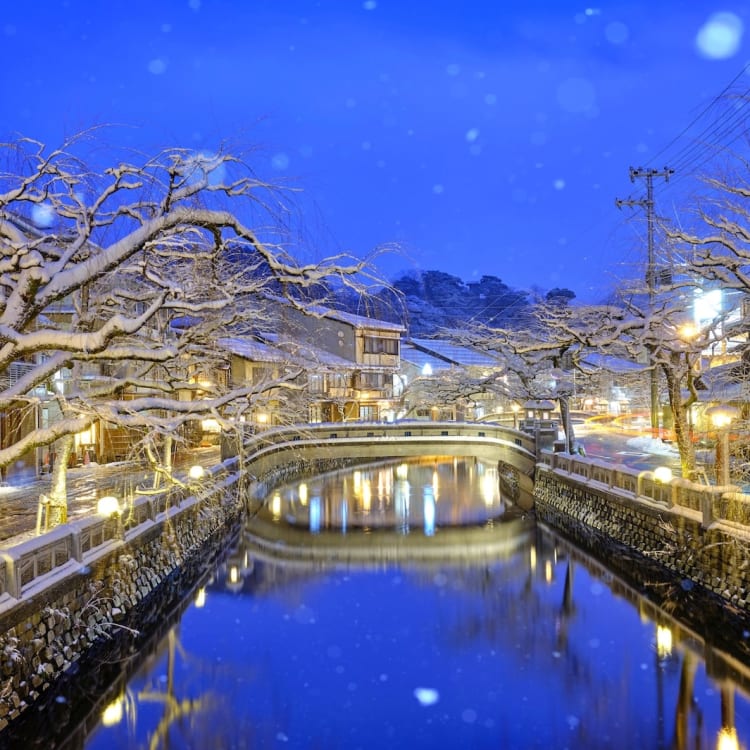
STORY 7 tattoo-friendly onsen in Japan
Experience onsen in Japan regardless of your tattoos
Japan’s onsen (natural hot springs) have been part of Japanese culture for thousands of years. A naturally occurring geothermal phenomenon found throughout Japan, onsen are the ultimate bathing experience. These peaceful sanctuaries, where you immerse yourself in mineral-rich waters, often in serene natural surroundings, have long been used to invigorate tired bodies and relax the mind. Many are also believed to offer health benefits, with the healing properties of the baths depending on the source of the water.
Traditionally, people with tattoos were banned from entering onsen due to the negative associations irezumi (the Japanese word for tattoo) have with criminality and gang affiliations. However, today there are now more and more onsen facilities declaring themselves ‘tattoo-friendly’.
Here is a guide to 7 tattoo-friendly onsen in Japan.
1. Dogo Onsen
Ehime Prefecture
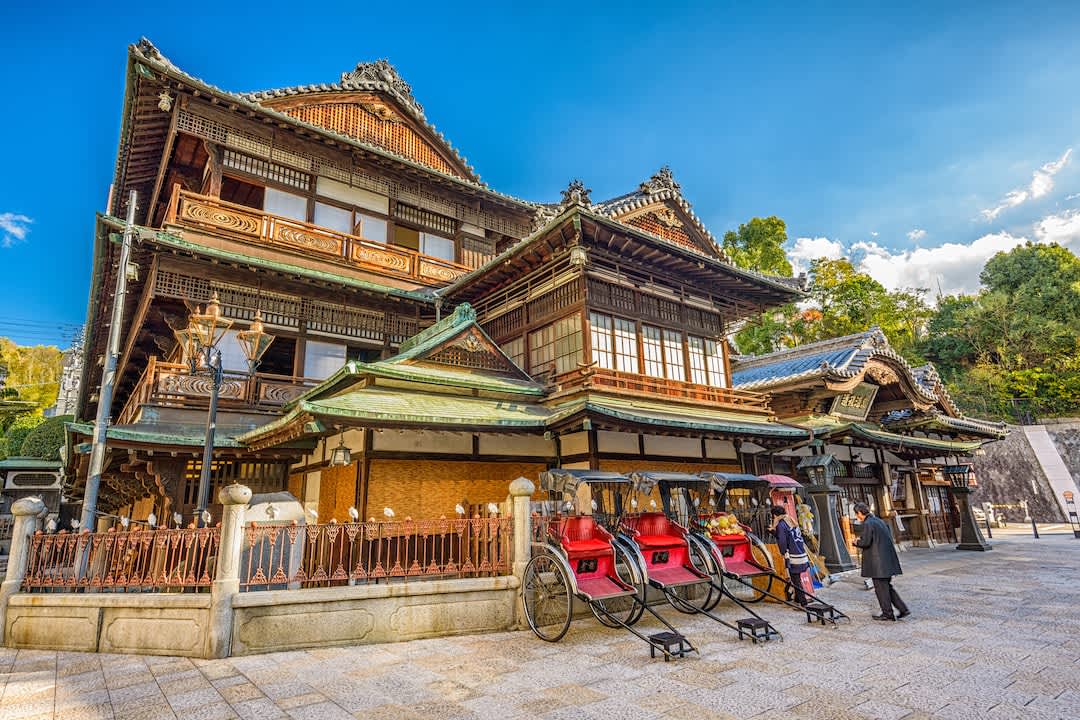
Dogo Onsen bathhouse – one of the oldest in Japan. Image: Sean Pavone/Shutterstock.com
Dogo Onsen is said to be one of Japan’s oldest hot springs. Since ancient times, it has been visited by many Japanese artists and nobility and also featured in famous Japanese literary works such as Natsume Soseki’s novel ‘Botchan’.
The symbol of the onsen, Dogo Onsen Honkan bathhouse, is a 3-storey wooden building with over 3,000 years of history and is recognised as a National Important Cultural Property. It houses two bathing areas and offers several bathing experiences at various price points. You can also visit two other bathhouses: Dogo Onsen Annex Asuka-no-Yu which features open-air baths and is based on the architectural style of the Asuka Period (550-710), and Dogo Onsen Tsubaki-no-Yu, which has a more modern atmosphere.
All visitors are welcome to experience the peaceful atmosphere of Dogo Onsen as the baths in all three bathhouses are tattoo-friendly.
Note: Dogo Onsen Honkan bathhouse is currently undergoing conservation and repair works but Tama-no-Yu, the bath on the ground floor is open for bathing. The construction work is expected to finish by December 2024. Please refer to the official website for the latest updates.
2. Kinosaki Onsen
Hyogo Prefecture
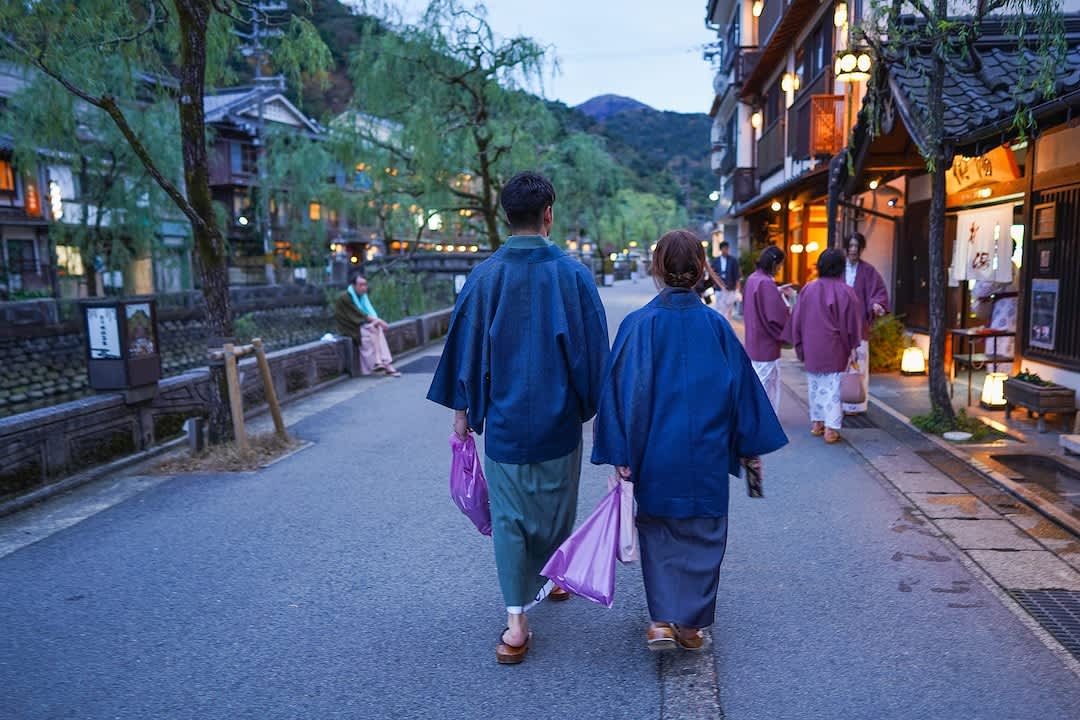
Japanese couple wearing yukata walking at Kinosaki Onsen. Image: Rei Imagine/Shutterstock.com
Only 2.5 hours by train from Kyoto City, you can find the famous Kinosaki Onsen. Home to 7 natural hot springs and adored by the Japanese for over a millennium, the onsen’s cosy atmosphere attracts visitors from all over the world. An idyllic place to relax and unwind, expect to see beautifully preserved architecture and an ambience like no other.
The 7 public hot springs are all located within walking distance of one another, so it’s easy to visit each one on an ‘onsen hop’ across town. Each bath has its own style, history and charm – making each bathing experience different to the last. You can also enjoy a number of foot baths around town for free.
As you wander the town, keep an ear out for the rhythmic clip-clopping of visitors’ geta (traditional wooden sandals) as they stroll along the streets dressed in yukata (casual cotton kimono).
If you stay in one of the town’s ryokan (Japanese-style inn), you will usually be given a pass to use the public onsen for free during your stay. Alternatively, you can purchase a day pass that will grant you entry to all 7 public bathhouses for the day. Each ryokan has its own rules about tattoos, but all 7 of the public onsen are tattoo-friendly.
3. Otakinoyu
Gunma Prefecture
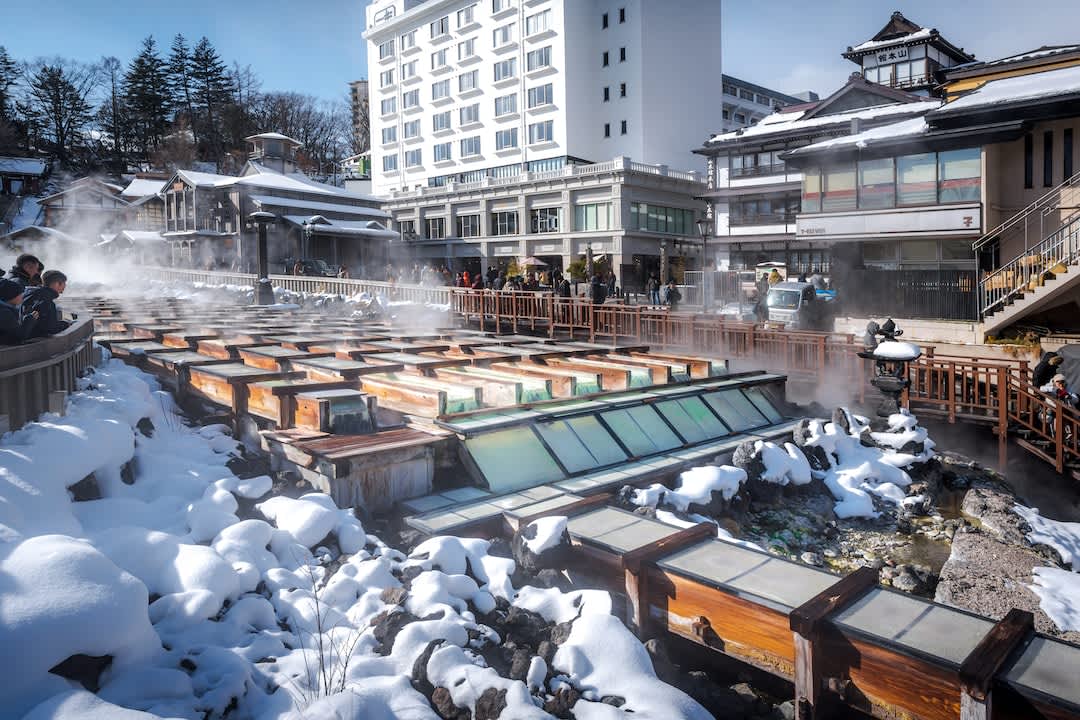
Yubatake (hot water field) at Kusatsu Onsen, Gunma Prefecture. Image: Infinity T29/Shutterstock.com
Take part in an ancient Japanese bathing routine at Otakinoyu Onsen. The onsen gives bathers a chance to experience the traditional awase-yu style of bathing, where you bathe in baths that gradually increase in temperature, from a considerably comfortable 38 degrees to a steaming-hot 46 degrees.
The beautiful wooden bathhouse also allows visitors to experience open-air baths. Private baths are available as well for families and couples looking to have a more intimate bathing experience together.
Otakinoyu also provides a full resort experience, with a lounge café, sauna and massage rooms as well as relaxation rooms that are available for private rental.
4. Shibaseki Onsen
Oita Prefecture
![]()
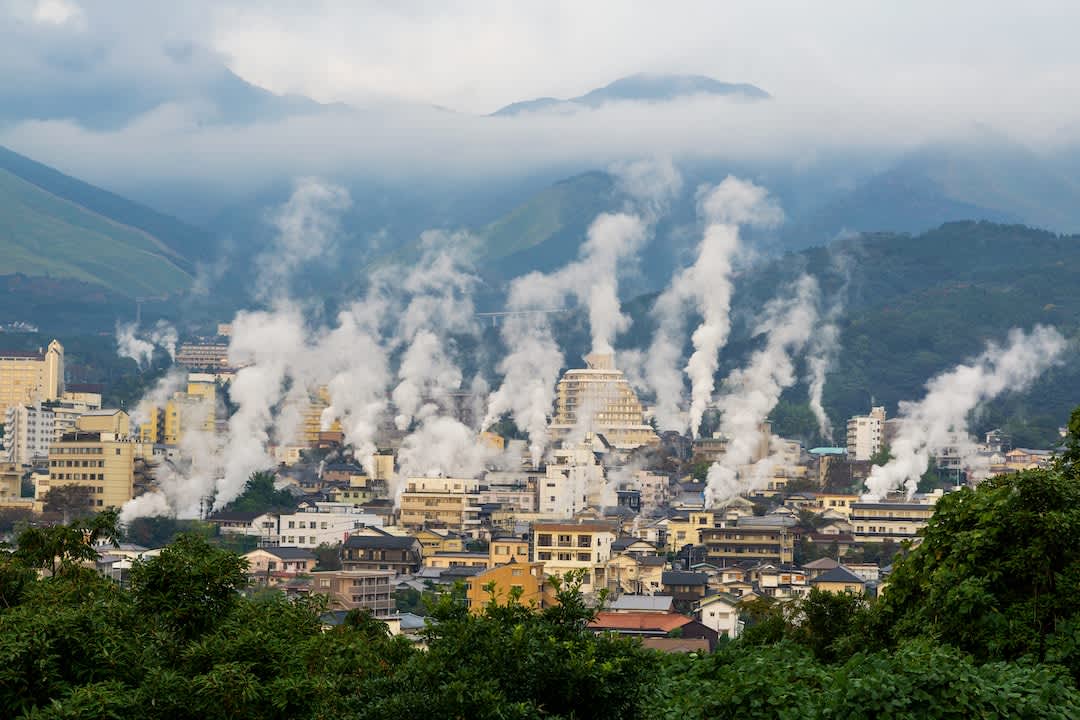
The onsen town of Beppu, Oita Prefecture with steam rising from the natural hot springs. Image: Journey is bliss/Shutterstock.com
Shibaseki Onsen is located in picturesque surrounds and derives its name from the fossils called shibaseki which were found here during the Edo Period (1603-1867). It boasts a long history, and it’s believed that Emperors Daigo and Goreizei frequented its healing waters in 895 and 1044.
The building was renovated around 20 years ago but retains its traditional wooden and stone features. With wide, mountain hut-style windows and high ceilings, it creates a calm and healing space for visitors to enjoy a relaxing soak.
You can also find a variety of baths including indoor, open-air, steam and private baths. The baths also come in three different water temperatures, making it ideal for everyone from beginners to frequent onsen goers. Choose the temperature of water you prefer to ensure a relaxing experience catered to your needs.
5. Yamato-no-Yu
Chiba Prefecture
![]()
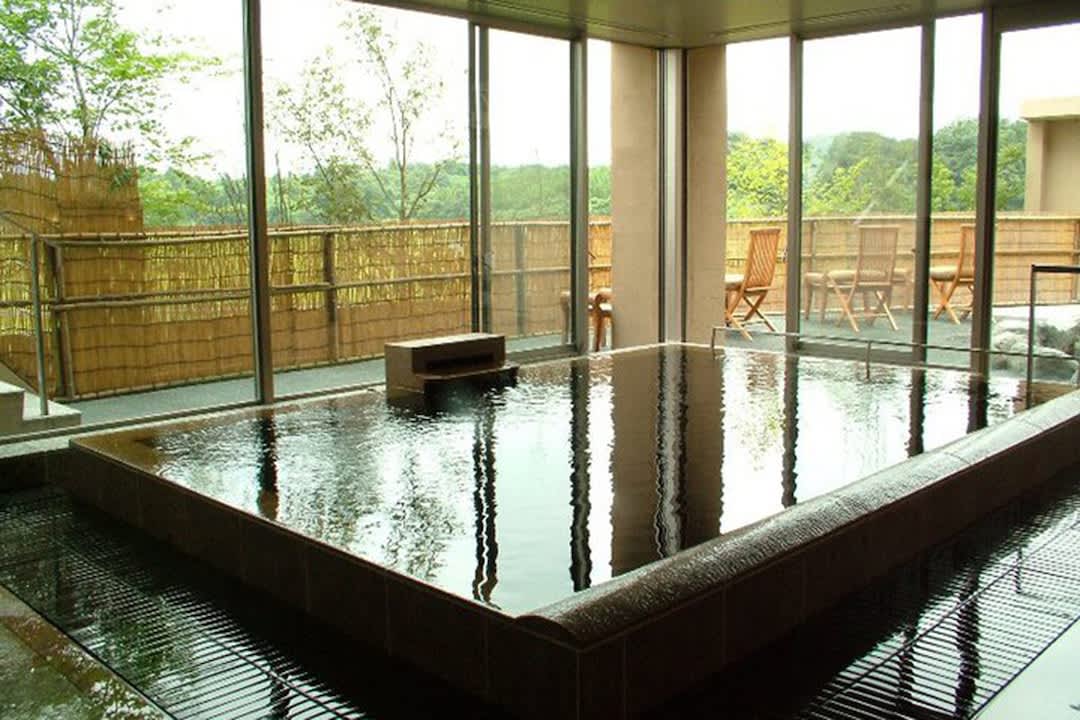
Indoor bath at Yamato-no-Yu. Image: Tattoo Friendly
Only about 40 minutes from Narita Airport, you can find the stunning Yamato-no-Yu onsen. Its main indoor bath provides an ever-flowing stream of fresh spring mineral water while giving you a picturesque view of vibrant rural scenery.
The onsen also houses 8 open-air baths including those with wooden tub baths as well as Jacuzzis. For couples or families seeking a private bathing experience, you can also reserve a room that comes with its own private outdoor bath.
Don’t forget to check out the unique Radiant Bath. This bathing area is designed to maintain a temperature of 1 to 1.5 degrees above your normal body temperature – helping you feel relaxed and healed.
Please be advised that Yamato-no-Yu allows entry for primary school age and above only.
6. Saki-no-Yu
Wakayama Prefecture
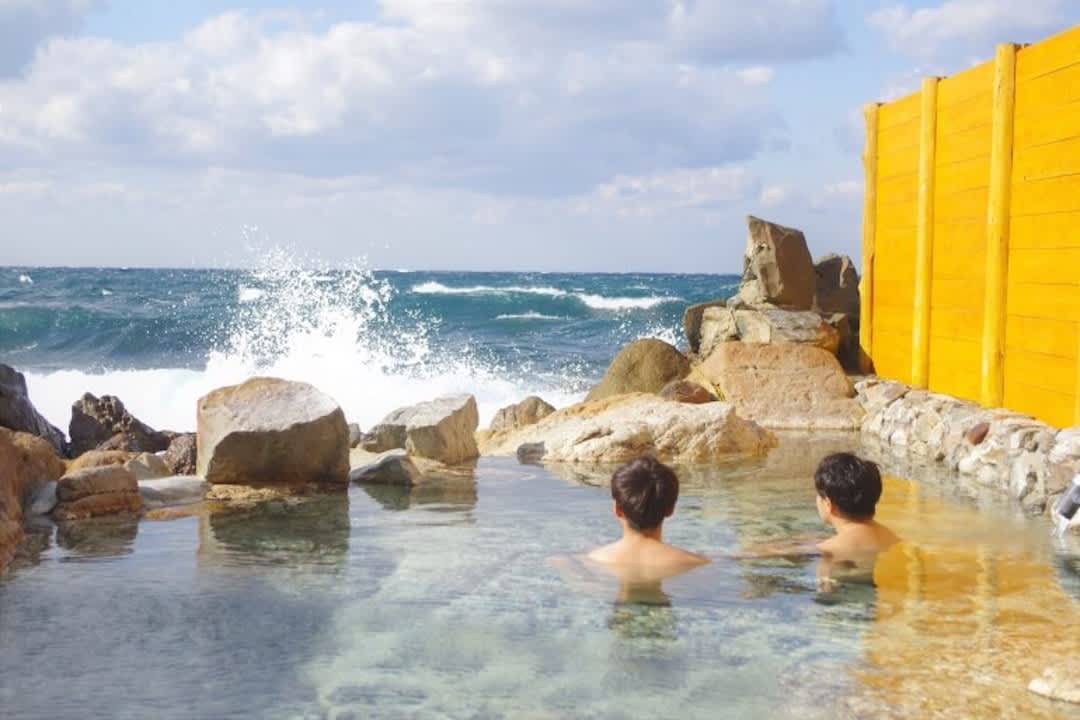
Saki-no-Yu onsen with waves crashing in front of bathers.
Saki-no-Yu in Shirahama is a breathtaking rotenburo (open-air bath) with panoramic views of the Pacific Ocean.
As you relax in this free-flowing open-air bath of Saki-no-Yu, you’ll witness an incredible view of waves crashing onto rocks and may even feel a light sea spray, making for a truly unique experience.
A short distance from Saki-no-Yu, you can find the stunning Shirarahama Beach (white sand beach). With pristine white sand shipped all the way from Australia and sparkling waters, the beach is as close to a Pacific Ocean paradise as you can find. The beach is a favourite amongst sun-lovers and heralds Japan’s beach season.
7. Hottarakashi Onsen
Yamanashi Prefecture

Open-air bath with a view of Mt Fuji at Hottarakashi Onsen. Image: Hottarakashi Onsen
With Mt Fuji straight ahead and the Kofu basin down below, the panoramic views you’ll experience in this onsen will simply take your breath away. Take a relaxing open-air bath while you admire the stunning Kofu plains and its surrounding mountains and lush greenery.
Hottarakashi Onsen has two baths: Kocchi-no-Yu, popular for its wooden and rocky open-air bath with views of Mt Fuji, and Acchi-no-Yu, newer and twice as large as Kocchi-no-Yu, which commands the night and morning sunrise view of the Kofu basin.
Hottarakashi Onsen opens one hour before sunrise and stays open until after sundown to allow visitors to experience dawn and dusk. Make sure to try the onsen’s specialty food, ontama-age as well.
Tips for going to onsen if you have tattoos:
Tip 1: Use cover-up methods
If you wish to visit an onsen that doesn’t allow tattoos, there are a range of different tattoo coverup methods to consider. You can use a wide range of tapes and coverings, many of which come in different shades for different skin tones. They are readily available in drugstores and are sometimes sold at the front desk of the onsen facility. You simply remove the clear film and stick it on.
However, please note that some places won’t allow tattoos even if they are covered up while others may allow them if they are under a certain size.
Tip 2: Visit a sento
Sento are public baths, dotted throughout communities in Japan. They are typically more affordable and centrally located than onsen – making them an easy way to experience traditional Japanese bathing culture.
Sento have separate baths for male and female guests. Inside, each stall is equipped with a stool and bucket. Take a seat and start pouring the hot water over yourself, being mindful to not splash other people. See the differences between sento and onsen here.
Tattoos are typically accepted in public baths however it is always a good idea to double-check.
Tip 3: Book a private onsen
Private onsen known as ‘kashikiri buro’ are a fantastic alternative if you wish to experience Japanese bathing culture without the need to cover up your tattoos. These private onsen, while smaller to public ones, give you the privacy and comfort of having exclusive access to your own hot spring.
Learn all you need to know about onsen etiquette in our onsen guide.



















































